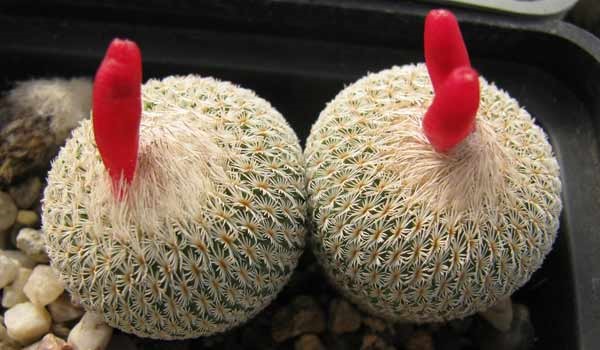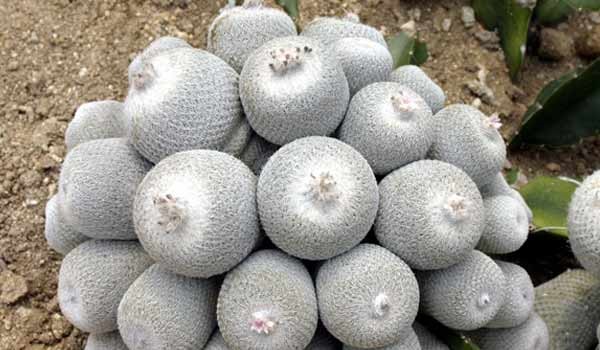Epithelantha Micromeris (Button Cactus) Guide

An Epithelantha Micromeris “Button Cactus” is a plant that can complement a succulent collection as perfectly as your windows or your workstation. This cute cactus resembles a small ball covered with white-grey radial spines.
Sometimes these spines are so dense, that it can make you think that it is just a ball of grey spines. But underneath, there is the charming Epithelantha Micromeris ready to brighten up your space with its unique shape and flowers. And Now, Let us get to know the Button Cactus better.
Button Cactus Information
Native to Madagascar, the Button Cactus consists of a dark green globular-shaped stem and its signature spines. In its original habitat, it can grow up to 12 inches (30.5 cm) tall and 36 inches (91 cm) wide.
Also known as the Ping-Pong Ball Cactus, the Epithelantha Micromeris flowers are super cute, very small, and have a white-pink color that appear in the late winter or early spring. They are also edible and later turn into cylindrical, bright-red fruits in late spring or early summer that have a few black seeds inside them. The Epithelantha Micromeris seeds are also edible.

Epithelantha Micromeris Care
Button Cactus plants care is not so much different than other succulents. With minimum care, you can add this lovely house plant to rock gardens or any part of your home and office. Keep reading to find out how you can grow your future Button Cactus:
Light
Similar to other cactus species, Button Cactus plants love receiving full sunlight and perform best in such spots. Although, they can adapt to partial shade just fine.
For growing the Ping-Pong Ball Cactus outdoors, find a bright spot with 6 hours of direct sunlight. For growing indoors, also find a spot with full to partial sun to keep this plant. A southern-facing window should do it; of course, if you are living in the Northern Hemisphere.
Temperature
Epithelantha Micromeris is not cold hardy, and the best temperature to keep it is above 20° F (-6.7° C). If your winters are colder, make sure to move it indoors.
Water
As for other succulents, we recommend using the “soak and dry” method for the Button Cactus as well. It means that you only need to water this cactus when the soil is dried out completely. Avoid overwatering at all costs, as the Button Cactus is very sensitive to root rot.
Tip: If you watered too much in one of the sessions, give your plant a few minutes to absorb as much water as it needs; and then make sure to pour the excess water off.
Soil
Since root rot is a common problem for Epithelantha Micromeris, the soil should be very well-draining. To prepare such soil, you can go for store-bought options specifically designed for cacti, or combine potting soil, turface, and crushed granite.
Tip: Do not skip the crushed granite as it forms air pockets in the soil and allows water to flow freely, and keeping your Ping-Pong Ball Cactus from getting too much water.
Repotting
The Button Cactus has a slow growth rate and you do not need to repot it often. Although, when you buy it from the store, it is necessary to repot it.
This plant is not toxic for us nor our pets. However, its spines can irritate the skin. So do not forget to wear gardening gloves.

How to Propagate the Button Cactus
To propagate this plant, you can choose between Epithelantha Micromeris Seeds and offsets:
Epithelantha Micromeris Seeds
Propagating by seeds is going to be challenging, as this is a difficult and slow type to grow. We do not recommend this method, but if you are serious, plant the seeds in a well-draining soil mixture. If you are living in a cool area, make sure to propagate these blackish seeds indoors.
Also, using growing lights and a seed mat increase your chance of success.
Button Cactus Offsets
The common and convenient way to propagate Epithelantha Micromeris is by its offsets. If you have a Ping-Pong Ball Cactus that is several years old, you can consider it a mother plant and start obtaining offsets. For propagation:
- Remove an offset from the mother plant using a clean and sharp razor or knife, and clean the extra soil from it.
- Let the cuttings callous for a few days and plant them in well-draining soil and a pot or container with drainage holes.
- Remember to water only when the soil is dried out.
And just like that, soon you will have little cacti to grow and gift to others.
As you can see, everything is ready to add your own Epithelantha Micromeris to your space and collection. Do not hesitate more than you have had, and let the Button Cactus add some color and charm to your life!
- In this post:
- Button Cactus Information
- Epithelantha Micromeris Care
- How to Propagate the Button Cactus



